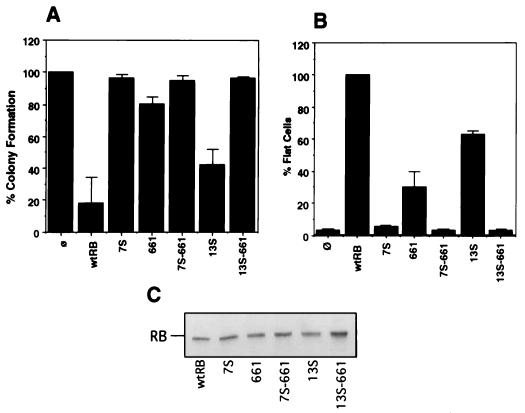FIG. 5.
Effects of C-pocket mutations on terminal growth arrest. (A) Inhibition of neomycin-resistant colony formation. The vector used to express RB and the various mutants contained a neomycin resistance gene. The expression plasmid DNA was transfected into Saos-2 cells. Transfectants were subjected to G418 selection for 2 to 3 weeks. The number of neomycin-resistant colonies arising from each transfectant was counted and expressed as a percentage relative to the number of such colonies in the vector-alone transfectant, which was considered 100%. Results shown are the means and standard deviations of results of four independent experiments. wtRB, wild-type RB; ø, vector-cotransfected cells. (B) Induction of flat-cell formation. Saos-2 cells were cotransfected with pCMVneo-RB, -7S, -13S, -661, –7S-661, –13S-661, or -vector and a puromycin resistance plasmid. Transfected cells were selected with puromycin for 7 days. Resulting flat cells were counted in each dish, and the number of flat cells formed for each transfectant was expressed a percentage of the number of flat cells formed by RB, which was considered 100%. Results shown are the means and standard deviations of results from four independent experiments. (C) Protein expression levels. The amount of plasmid transfected was titrated to yield equal levels of RB protein expression. Saos-2 cells transfected with RB, 7S, 661, 7S-661, 13S, or 13S-661 were divided into three equal parts: one-third of the cells was used for the colony formation assay (A), one-third was used for the flat-cell assay (B), and one-third was collected at 48 h posttransfection for protein analysis (C). Equal amounts of total protein from lysates collected from the transfected cells were separated on an SDS–7.5% polyacrylamide gel. RB proteins were detected with anti-RB 245 antibody (Pharmingen). The transfected pCMV-RB expression construct for each lysate is indicated.

